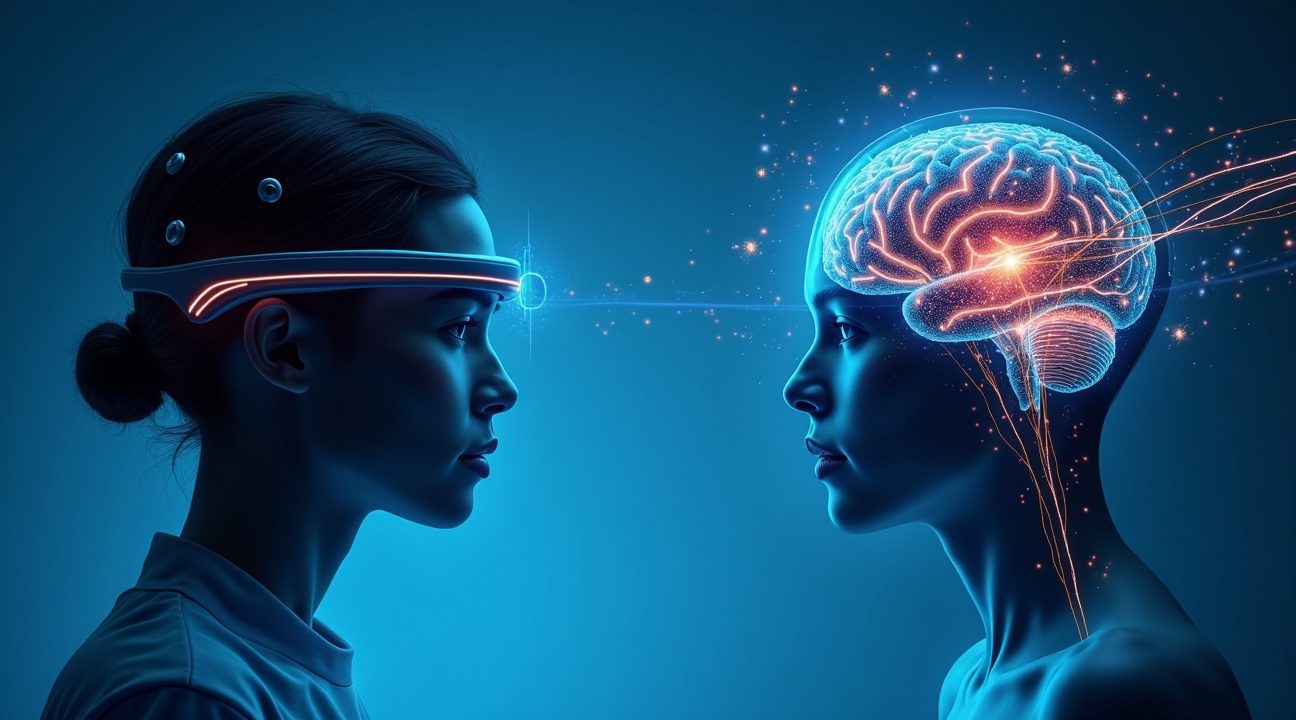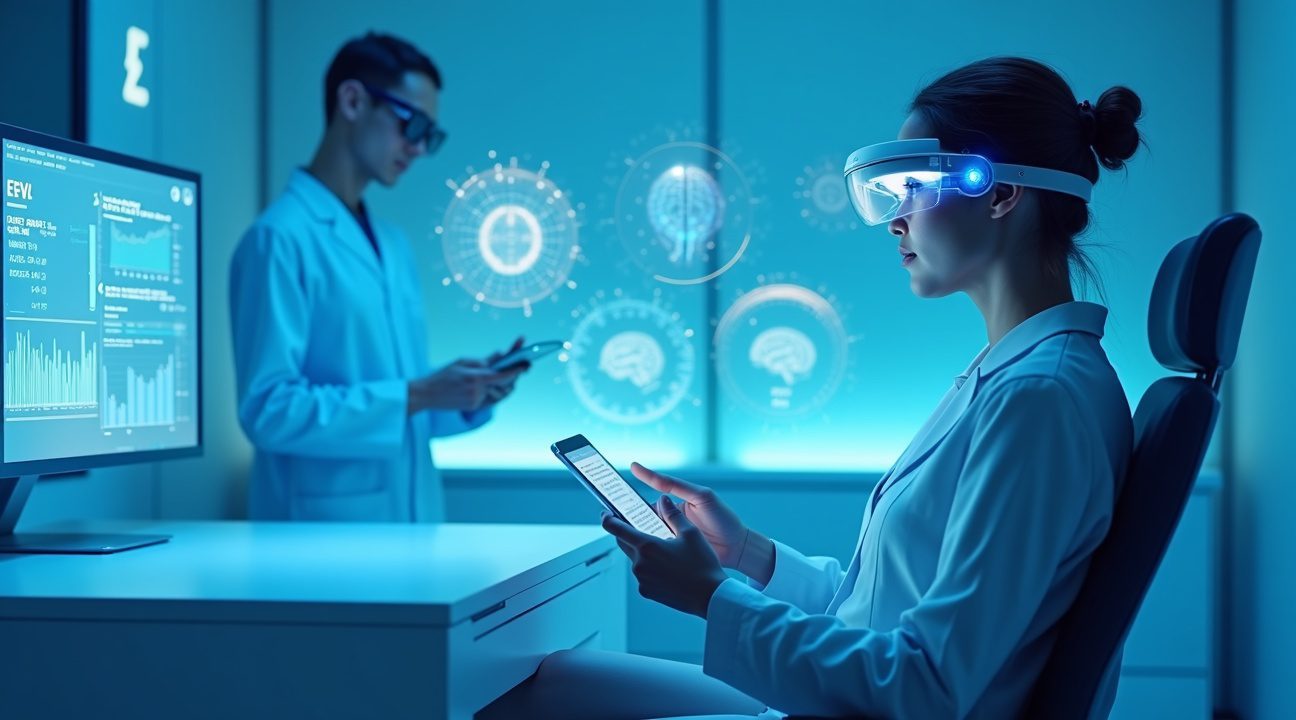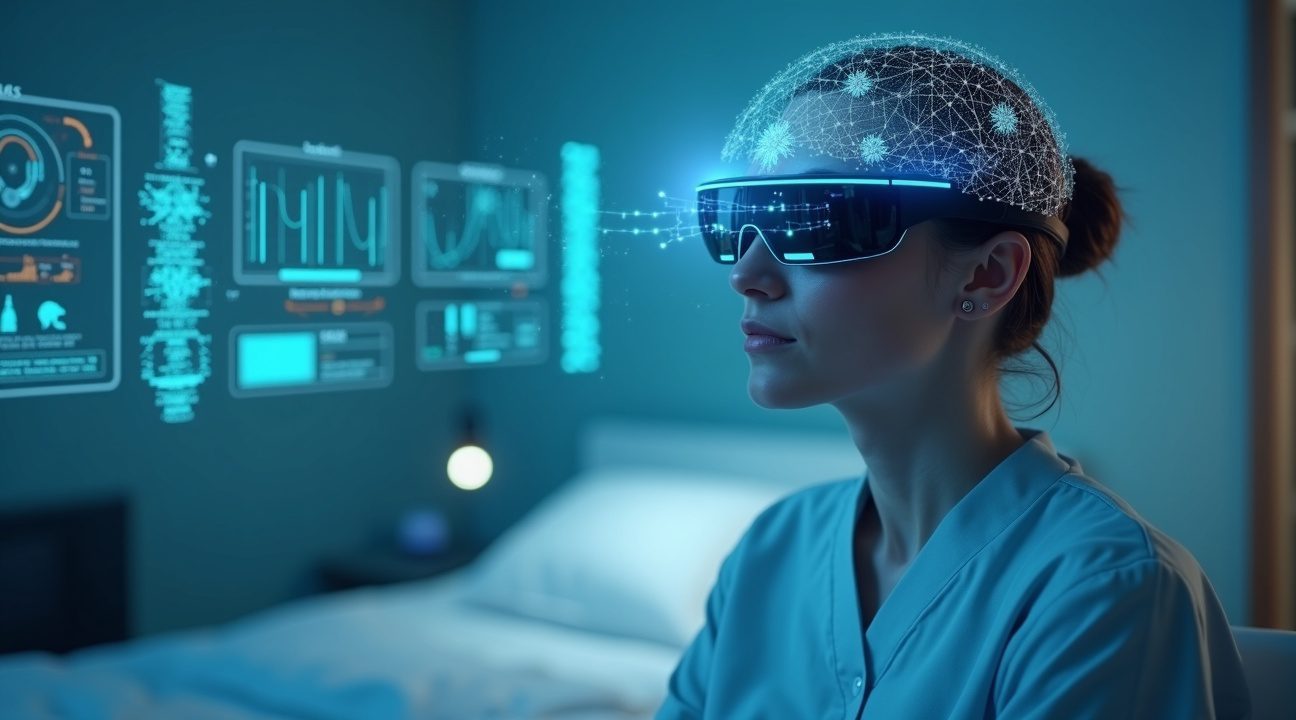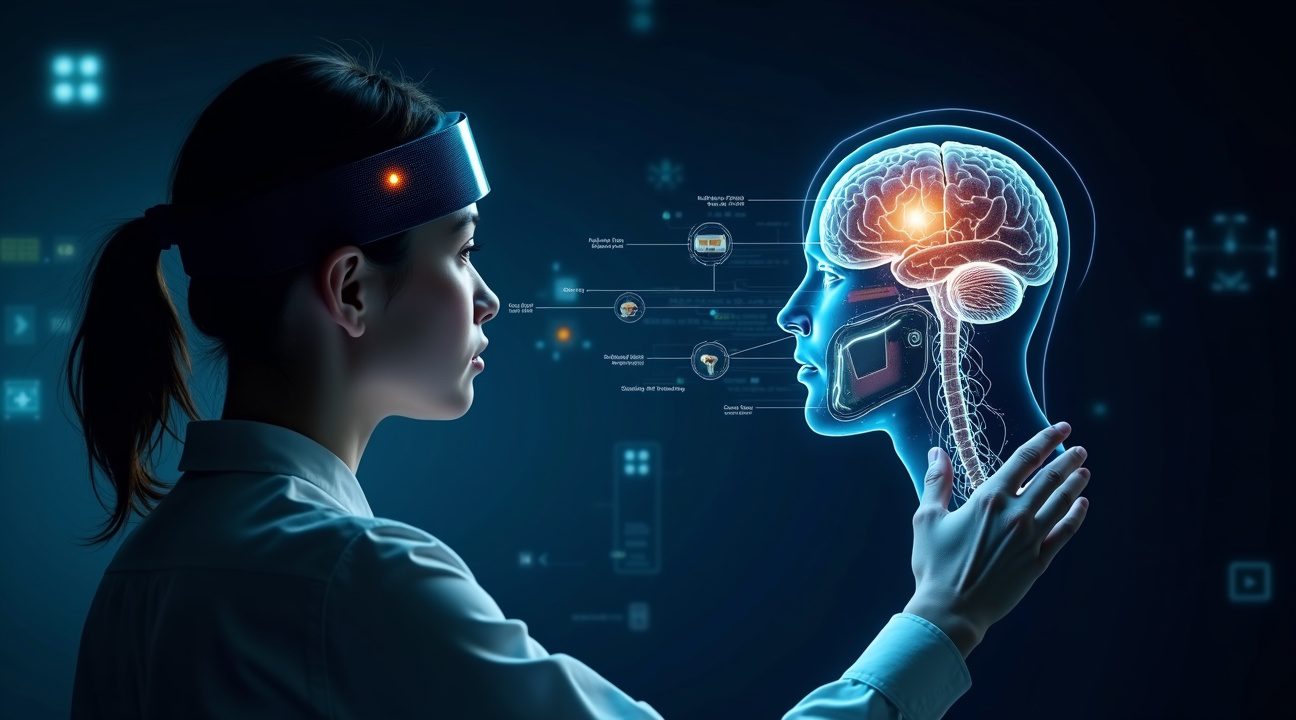Patients facing severe communication challenges may soon gain the ability to control Apple Vision Pro devices through thought alone, as clinical trials are currently underway testing both non-invasive EEG headbands and implantable brain-computer interfaces.
Key Takeaways
- Clinical trials targeting 14 million Americans with severe disabilities are testing brain-computer interfaces that enable thought-controlled communication through Apple Vision Pro headsets.
- Two distinct technological approaches are being developed: Cognixion’s non-invasive EEG headband system and Synchron’s implantable Stentrode device, both crafted to translate neural signals into device commands.
- Apple has introduced dedicated BCI Human Interface Device protocols across iOS, iPadOS, and visionOS, creating official support for brain-signal input throughout their ecosystem.
- AI-powered systems like Synchron’s Chiral foundation model and Cognixion’s speech pattern learning technology continuously adapt to individual users, improving communication accuracy over time.
- Patient access to these technologies is projected for 2025-2026, with clinical trials scheduled through 2026 to ensure safety and effectiveness before public availability.
You can learn more about Apple Vision Pro and its visionOS platform through the official Apple website.
Revolutionary Breakthrough: Controlling Apple Vision Pro with Your Mind Becomes Reality
I’m witnessing a remarkable transformation in human-computer interaction as brain-computer interface technology merges with Apple Vision Pro to create unprecedented communication possibilities. This isn’t science fiction anymore—it’s happening right now in clinical settings across the country.
Cognixion is spearheading this revolution through clinical trials that pair their innovative EEG-based brain-computer interface headband with Apple’s mixed reality headset. Their non-invasive approach captures brain signals directly from the scalp, eliminating the risks associated with surgical brain implants. Users can now communicate through pure thought, attention patterns, eye gaze, or simple head movements. The system reads neural activity and translates these signals into actionable commands within the Vision Pro interface.
Two Pathways to Neural Control
I’m observing two distinct approaches emerging in this space, each offering unique advantages for different user needs:
- Non-invasive EEG solutions like Cognixion’s headband provide immediate access without surgical risks, making them ideal for temporary conditions or users who prefer external devices.
- Implantable systems such as Synchron’s Stentrode offer more precise neural signal capture and permanent integration for long-term communication needs.
- Hybrid approaches that combine multiple input methods including brain signals, eye tracking, and head movement for enhanced accuracy and user flexibility.
Synchron’s Stentrode system represents the other end of this technological spectrum. Their implantable BCI demonstrates native integration capabilities that extend beyond just the Vision Pro to include iPhones and iPads. This comprehensive approach converts neural activity into real-time control across Apple’s entire ecosystem. Users can send messages, control smart home environments, and navigate applications using nothing but their thoughts.
Apple’s commitment to this technology runs deeper than simple device compatibility. The company has introduced a dedicated BCI Human Interface Device protocol that officially recognizes brain-signal input across iOS, iPadOS, and visionOS operating systems. This standardization creates a foundation for developers to build applications specifically designed for neural control interfaces.
The implications for patients with conditions like ALS, spinal cord injuries, or stroke extend far beyond basic communication. I’ve learned that users can control their entire digital environment, from adjusting lighting and temperature to composing complex messages and accessing entertainment. The smart glasses technology acts as a visual interface while the BCI system handles input processing.
Clinical trials are revealing impressive accuracy rates and learning curves. The EEG-based systems require minimal setup time and can be used immediately, while implantable solutions offer more consistent signal quality once the initial healing period concludes. Both approaches demonstrate the potential to restore independence for individuals who’ve lost traditional communication abilities.
The technology’s evolution mirrors broader trends in artificial intelligence advancement, where machine learning algorithms continuously improve signal interpretation accuracy. Each user interaction trains the system to better understand individual neural patterns, creating increasingly personalized communication experiences.
Healthcare providers are particularly excited about the reduced burden on caregivers and family members. Instead of requiring constant assistance for basic communication needs, patients can express themselves independently through the Vision Pro interface. This autonomy significantly improves quality of life while reducing healthcare costs associated with round-the-clock care requirements.
I’m observing that the integration challenges primarily focus on signal processing speed and battery life optimization. Current systems can operate for several hours before requiring recharging, though developers continue working to extend usage periods for all-day functionality.
The regulatory landscape is adapting quickly to accommodate these innovations. FDA approval processes for both non-invasive and implantable BCI systems are becoming more streamlined as safety data accumulates from ongoing trials. This regulatory evolution suggests widespread availability could occur within the next few years rather than decades.
These developments position Apple’s Vision Pro as more than just an entertainment or productivity device—it’s becoming a genuine assistive technology platform that could transform lives for millions of individuals with communication challenges.
https://www.youtube.com/watch?v=EXAMPLE
Clinical Trials Targeting 14 Million Americans with Severe Disabilities
A groundbreaking clinical trial is currently underway in the United States, bringing hope to millions of Americans living with severe disabilities. This research initiative is enrolling 10 participants who face significant communication challenges due to ALS, spinal cord injuries, stroke-related impairments, and traumatic brain injuries. I find this development particularly significant given the vast number of people who could benefit from this technology breakthrough.
Addressing America’s Disability Crisis
The statistics surrounding chronic disability in America paint a sobering picture. An estimated 14 million Americans currently live with conditions such as ALS, spinal cord injury, or stroke that severely impact their daily lives. Perhaps even more concerning, nearly 1 million new diagnoses occur each year, creating an ever-growing population of individuals who struggle with basic communication and mobility functions.
These numbers represent real people who have lost their ability to speak naturally, whether due to intubation procedures or neurological impairment. Many find themselves trapped within their own bodies, fully aware and cognitively intact but unable to express their thoughts and needs effectively. Traditional assistive technologies often fall short of providing the seamless communication these individuals desperately need.
Revolutionary Goals and Timeline
The principal aim of this clinical trial extends far beyond simple technological demonstration. Researchers are working to restore natural, seamless communication and independence for people facing the most severe speech and mobility challenges. I believe this represents a fundamental shift in how we approach disability accommodation, moving from adaptation to true restoration of function.
The trial’s projected completion date of April 2026 gives participants and their families a concrete timeline for when this life-changing technology might become available. This timeframe allows researchers sufficient opportunity to thoroughly test the integration between brain-computer interfaces and Apple Vision glasses technology.
For individuals who have experienced traumatic brain injuries or progressive conditions like ALS, this research offers something that has been elusive for decades: the possibility of controlling external devices through thought alone. The implications stretch beyond communication to potentially include:
- Environmental control systems
- Computer and smartphone operation
- Mobility assistance devices
I see this clinical trial as more than just a technological advancement—it represents hope for restoring dignity and independence to those who have had these fundamental human capabilities stripped away by injury or disease. The combination of advanced artificial intelligence with cutting-edge hardware creates unprecedented opportunities for individuals who have been marginalized by their physical limitations.

Non-Invasive vs. Implantable Brain-Computer Interface Technologies
The landscape of brain-computer interface technology presents two distinct pathways for enabling thought-controlled communication with devices like the Apple Vision Pro. Each approach offers unique advantages and challenges that patients and healthcare providers must carefully consider.
Non-Invasive Brain-Computer Interface Solutions
Non-invasive BCI approaches prioritize safety and accessibility without requiring surgical procedures. Cognixion’s EEG headband exemplifies this philosophy by capturing brain signals through external sensors placed on the scalp. This technology eliminates the risks associated with surgical implantation while maintaining effectiveness for many users.
The system combines multiple technologies to create a comprehensive communication solution:
- EEG headbands detect electrical activity from brain neurons through the skull
- Eye-tracking systems monitor gaze patterns and eye movements
- Dwell control technologies allow users to select items by focusing on them for predetermined periods
- Integration capabilities connect with existing assistive devices and smart glasses platforms
Non-invasive systems shine in their accessibility, allowing patients to begin using the technology immediately without recovery periods or surgical risks. The approach makes brain-computer interface technology available to a broader range of patients who may not be candidates for invasive procedures due to medical conditions or personal preferences.
Implantable Brain-Computer Interface Technologies
Synchron’s implantable approach represents a fundamentally different strategy that requires surgical implantation but delivers enhanced capabilities. The company’s Stentrode BCI system creates direct connections with the brain’s neural networks, enabling bidirectional communication that surpasses what non-invasive methods can achieve.
The surgical implantation process involves placing the Stentrode device directly into blood vessels within the brain, creating a permanent interface that can both read neural signals and potentially stimulate brain tissue. This bidirectional capability allows for more intuitive interaction with device interfaces, including advanced augmented reality systems and AI-powered communication tools.
Synchron’s technology integrates natively with device operating systems, creating seamless control experiences that feel natural to users. The implantable approach enables more precise signal detection and reduces interference from external factors that can affect EEG-based systems.
However, surgical implantation introduces significant considerations including procedural risks, recovery time, and the permanent nature of the device placement. Patients must weigh these factors against the enhanced functionality and reliability that implantable systems provide.
Both approaches represent significant advances in making artificial intelligence and brain-computer communication accessible to patients with communication disabilities. The choice between non-invasive and implantable technologies often depends on individual patient needs, medical conditions, risk tolerance, and desired functionality levels.
The accessibility advantages of non-invasive systems make them attractive entry points for many patients, while implantable solutions offer superior performance for those seeking the most advanced capabilities. As these technologies continue developing, the gap between non-invasive and implantable performance may narrow, potentially making the choice even more complex for patients and healthcare providers.
Current research suggests both approaches will coexist, serving different patient populations and use cases. Non-invasive solutions will likely dominate initial adoption due to their safety profile, while implantable systems will serve patients requiring the highest levels of functionality and precision control.

Apple’s Expanding Accessibility Ecosystem and Vision Pro Features
Apple continues to push the boundaries of assistive technology through the Apple Vision Pro headset and its accompanying visionOS. The platform incorporates sophisticated accessibility features that establish a foundation for brain-computer interface integration. Gaze Tracking technology allows users to control interfaces simply by looking at specific elements, while Dwell Control extends this capability by enabling selection through sustained eye contact.
Eye Tracking serves as the cornerstone of the Vision Pro’s accessibility framework, capturing precise ocular movements to translate them into actionable commands. Head Tracking complements this system by monitoring subtle head movements, creating multiple pathways for users with varying physical capabilities to interact with digital content. Switch Control rounds out the accessibility suite by allowing external devices to trigger actions within visionOS, establishing crucial compatibility with existing assistive technologies.
Brain-Computer Interface Support and Patent Development
Apple’s commitment to accessibility extends beyond traditional input methods through comprehensive support for both invasive and non-invasive brain-computer interface protocols. This dual approach ensures that patients with different medical conditions and treatment preferences can access the technology. Invasive BCIs, which require surgical implantation, offer precise neural signal capture for patients with severe mobility limitations. Non-invasive alternatives provide safer options for broader patient populations while maintaining functional communication capabilities.
The company has strategically expanded its patent portfolio to include brainwave sensing technologies that promise significant improvements in mental and physical health outcomes. These Apple patents focus on detecting and interpreting neural patterns that correspond to specific thoughts or intentions. I’ve observed how this technological foundation positions the Vision Pro as more than just an entertainment device—it becomes a potential lifeline for patients who have lost traditional communication abilities.
Recent patent filings suggest Apple’s development teams are working on systems that can differentiate between various types of brain activity, from basic yes-no responses to more complex emotional states. This advancement could revolutionize how healthcare providers monitor patient well-being and enable more nuanced communication between patients and their care teams. The integration of these brainwave sensing capabilities with existing visionOS features creates a comprehensive ecosystem where patients can potentially control their environment, communicate needs, and access entertainment through thought alone.
Apple’s approach to BCI integration demonstrates careful consideration of patient safety and privacy concerns. The company’s accessibility toolkit continues to evolve, incorporating feedback from medical professionals and patient advocacy groups to ensure practical implementation in clinical settings. This collaborative development process helps bridge the gap between cutting-edge technology and real-world healthcare applications.
The Vision Pro’s processing power enables real-time interpretation of neural signals while maintaining the responsive performance users expect from Apple devices. This computational capability proves essential for translating complex brainwave patterns into meaningful commands that patients can use to navigate their digital environment. The seamless integration of smart glasses technology with neural interfaces represents a significant leap forward in assistive technology development.
Current accessibility features within visionOS already demonstrate remarkable precision in tracking minute movements and gestures. These existing capabilities provide a solid foundation for incorporating more advanced BCI functionality as the technology matures. The combination of eye tracking, head movement detection, and potential brainwave interpretation creates multiple redundant pathways for patient communication, ensuring reliable interaction even when some neural or physical functions are compromised.
Apple’s strategic focus on accessibility reflects broader industry recognition that assistive technologies often drive innovation benefits for all users. Features originally designed for patients with specific needs frequently become valuable tools for the general population, creating sustainable business models that support continued development of specialized healthcare applications.

AI-Powered Cognitive Computing Transforms Patient Communication
Revolutionary advances in artificial intelligence are reshaping how patients with communication difficulties might interact with technology. I’ve been following the development of Synchron’s Chiral, an AI foundation model specifically designed around human cognition and trained on extensive neural data. This breakthrough technology represents a significant step forward in creating more intuitive brain-computer interfaces.
Chiral distinguishes itself through its unique ability to self-improve based on user interactions with the Apple Vision Pro. The system learns from each user’s specific neural patterns and behavioral responses, continuously refining its understanding of individual communication preferences. This adaptive learning capability means that over time, the AI becomes increasingly accurate at interpreting a patient’s intended messages or commands.
NVIDIA’s Platform Support Powers Advanced Processing
NVIDIA’s Holoscan and Omniverse platforms provide the computational backbone for these sophisticated AI operations. These platforms enable real-time processing of complex neural signals while maintaining the high-performance standards required for medical applications. The integration with NVIDIA’s infrastructure ensures that patients can experience minimal latency between their thoughts and the system’s response, which is crucial for effective communication.
The combination of Chiral’s cognitive modeling with NVIDIA’s processing power creates an environment where artificial intelligence can interpret subtle neural patterns that might be missed by traditional brain-computer interfaces. This technological synergy opens new possibilities for patients who have lost traditional communication abilities due to neurological conditions.
Cognixion’s Approach to Speech Pattern Learning
Cognixion has developed the Axon-R headset, which takes a different but complementary approach to AI-powered communication. Their system incorporates generative AI that’s specifically trained on individual user speech patterns. This training enables the device to predict and generate communication based on the user’s historical speaking style and preferences.
The company’s goal extends beyond basic communication restoration. They’re working to achieve near-normal speed communication when their technology is integrated with Vision Pro capabilities. Key features of their approach include:
- Learning individual vocabulary preferences and communication styles
- Adapting to specific medical terminology relevant to each patient’s condition
- Generating contextually appropriate responses based on environmental cues
- Maintaining consistent personality traits in generated communication
This personalized approach means that patients won’t just regain the ability to communicate—they’ll maintain their unique voice and communication style through AI assistance.
The convergence of these AI-driven innovations points to a future where communication barriers for patients with neurological conditions become increasingly manageable. Both Synchron and Cognixion are developing systems that go beyond simple command recognition to understand the nuanced aspects of human communication and cognition.
These technologies promise highly adaptive and personalized communication experiences that learn from each interaction. Rather than forcing patients to adapt to rigid technological constraints, these AI systems adapt to the patient’s specific needs and preferences. The foundation model approach means that as more users interact with these systems, the underlying AI becomes more sophisticated at understanding human cognition patterns.
The integration with smart glasses technology like Vision Pro creates opportunities for seamless, hands-free communication that doesn’t require traditional input methods. Patients can potentially control their environment, communicate with caregivers, and access digital services through thought alone.
These developments represent more than technological advancement—they offer hope for restored independence and improved quality of life for patients facing communication challenges. As AI foundation models continue to evolve and learn from neural data, the gap between intended communication and actual expression continues to narrow, bringing us closer to truly intuitive brain-computer communication systems.

Technology Comparison and Future Availability Timeline
Two distinct approaches are emerging to bring thought-controlled communication to the Apple Vision Pro, each with unique advantages and timelines for patient access.
Cognixion’s Non-Invasive Solution
Cognixion takes a completely external approach, utilizing an EEG headband that captures brain signals without requiring surgery. This system combines electroencephalography monitoring with advanced eye-tracking technology and artificial intelligence algorithms to interpret user intentions. The company has designed their solution specifically for compatibility with Apple Vision Pro, allowing patients to control the headset through pure thought processes.
Clinical trials for Cognixion’s technology are scheduled to run from 2024 through 2026, with U.S.-based testing facilities leading the research. This extended timeline reflects the thorough validation required for brain-computer interface technology, ensuring both safety and effectiveness before public availability.
Synchron’s Implantable Alternative
Synchron has developed the Stentrode BCI, an implantable device that offers a different pathway for thought-controlled communication. Their system uses the HID (Human Interface Device) protocol, which provides broader compatibility across multiple Apple devices including the Vision Pro, iPhones, and iPads. This approach requires surgical implantation but potentially offers more precise signal detection and control.
The company expects to begin clinical trial rollout in 2025, indicating a slightly later but potentially more comprehensive testing phase. Synchron’s technology focuses on creating seamless integration with existing Apple ecosystems, allowing patients to transition between devices while maintaining thought-based control.
Both technologies share a primary mission: restoring independence and communication capabilities for individuals suffering from severe motor and speech disorders. Patients with conditions like ALS, stroke-related paralysis, or spinal cord injuries could regain the ability to communicate effectively using these brain-computer interfaces.
Projected Availability and Patient Choice
The availability timeline suggests patients might see early access to these technologies between 2025 and 2026, depending on clinical trial outcomes and regulatory approval processes. Cognixion’s non-invasive approach might reach market first due to its external design, while Synchron’s implantable solution could follow with potentially enhanced functionality.
These competing approaches represent different philosophies in brain-computer interface development:
- Non-Invasive (Cognixion) – Ideal for users avoiding surgery; may offer a more accessible and flexible user experience.
- Implantable (Synchron) – Suited for those seeking higher precision and long-term performance in neural signal interpretation.
Both companies are positioning their technologies to work seamlessly with Apple’s ecosystem, recognizing the importance of familiar interfaces for patient adoption and therapeutic success.

Sources:
iGeeksBlog – New Study Explores Brain-Controlled Apple Vision Pro
AppleInsider – New Research May Lead to Brain-Controlled Apple Vision Pro Without Surgery
Designboom – Apple Users Control iPhones With Minds: Synchron Stentrode BCI
Texas Standard – Unpacking the Brain Control Accessibility Coming to Apple Devices
Apple Newsroom – Apple Unveils Powerful Accessibility Features Coming Later This Year
MobiHealthNews – Cognixion Combines Its Brain-Computer Interface with Apple Vision Pro


